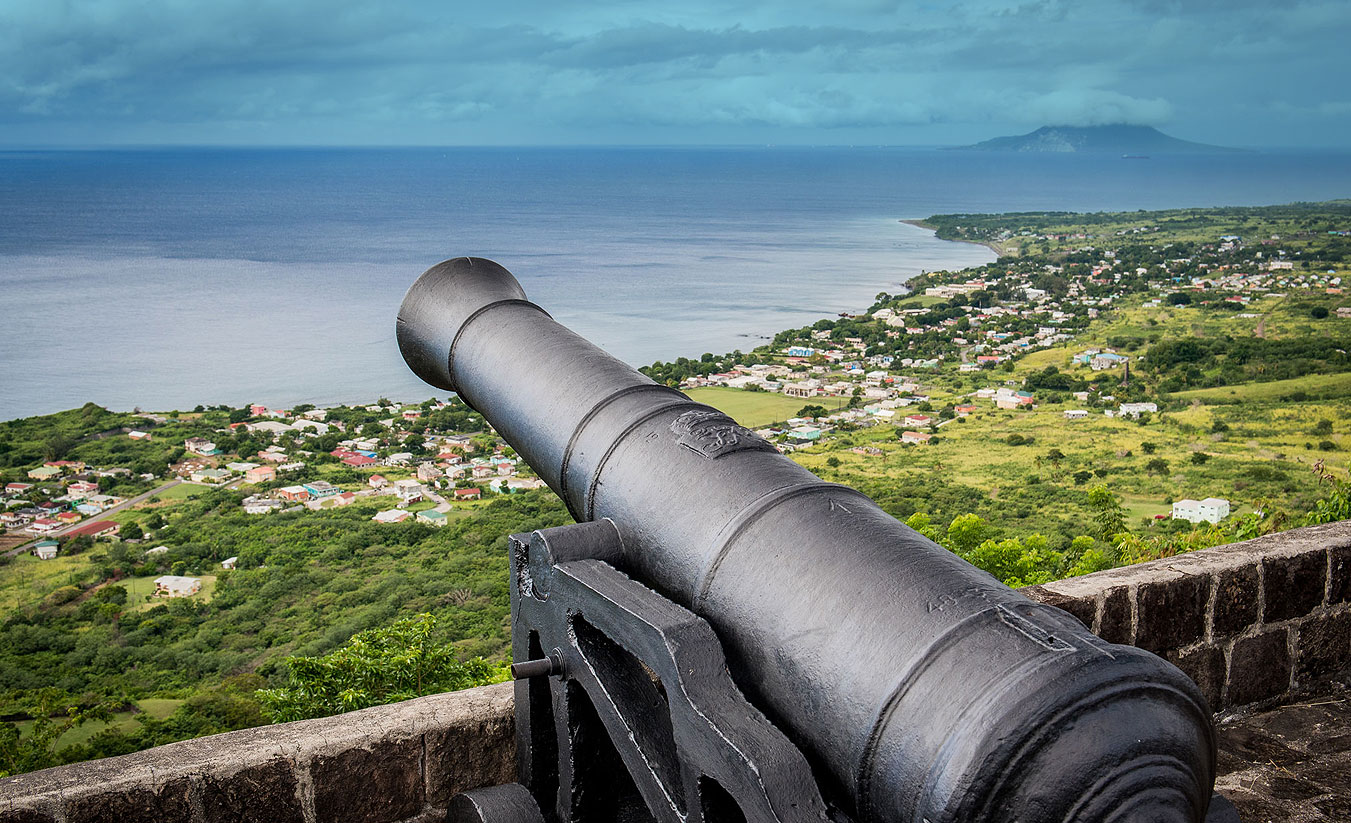National Provident Fund
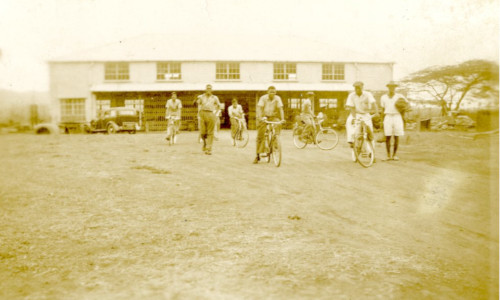
The National Provident Fund was introduced as an initial step in imporving social services. At the request of the Government of St. Kitts-Nevis-Anguilla, the Ministry of Overseas Development sent an expert to prepare a feasibility report. This was J.M Jordan of the Department of Health and Social Security.
The Act creating the Fund was passed by the House of Assembly on the 28th May 1968. It was to cover all persons between ages 16 and 60 under a contract of service and included casual labour and domestic servants. Registration of employers and employees took place in the few days between the passage of the Act and the operative date.
A contribution of 5c for every dollar earned was to be made by the employee and this was to be matched by the employer For the first two years the contribution of sugar industry employers was to come out of $125,000 dedicated for the purpose out of the Sugar Rehabilitation Fund. During the first year there were 50 recorded claims. 27 were for reaching 60 years of age, 22 for deaths, and 1 for permanent incapacitation amounting to $2711.00
It was the policy that the money collected should stay in the State so that it would be available for local development. All monies were deposited in Bank of America which guaranteed a 7% interest. Unfortunately this bank ran into problems in 1980 resulting in serious loss to persons who could ill afford them. A sum of $25,000 was placed in Barclay’s bank to be used in case of emergency. During the first year contributions amounted to $640,669. According to the Act, the Sugar Workers Pension Fund, held by the Crown Agents in London and amounting to over two million dollars were to be transferred to the NPF.
The first Director of the Fund was St. Clair Phillip, he was succeded by Robert Manning. Minister Fitzroy Bryant was the Chair of its Board of Control. By 1971, the expansion of the Fund was under consideration. In 1978, the National Provident Fund was replaced with the Social Security scheme.
The Survival of the Christmas Sport
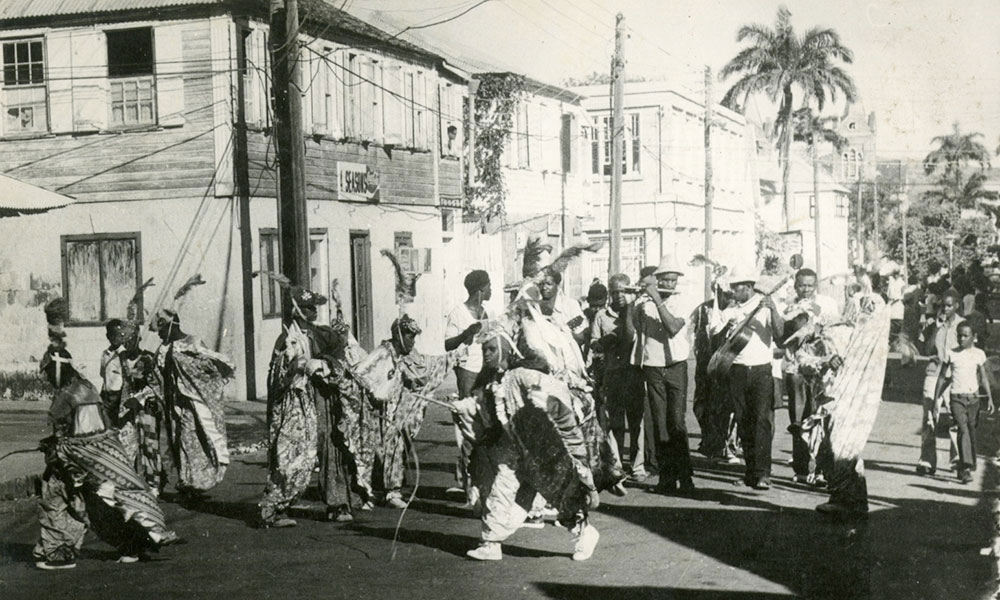
By Fidel O'Flaherty and Victoria Borg O'Flaherty
For two weeks at Christmas time, St Kitts comes alive to the rhythm of the big drum and string band, and the shrill notes of the fife as town and country are visited by troupes of the Masqueraders, Actors, Mummies, Moco Jombie, Clowns, and of course the Bull. There was a time when these troupes presented a much wider variety of performances but gone forever are David & Goliath, the Cake Walk, and Neaga Business. these troops were often lead by men like Longliner and Lalaps who came from the working class - a class of people who because of a lack or academic education was not usually associated with leadership capabilities.
For the plantation workers, who were always regimented on the estates this was a time to “Leh go”. It was a time when they could make fun of the social sins of the planters and the overseers and the white population in general. The often vulgar behavior of the performers became a subject of resentment among the emerging black intelligentsia. They feared that their blackness and their Creole origins would put them on a par with the performers in the eyes of the white administration and that this would diminish their potential to gain status in a white dominated society.
It was from the Black, middle class Intelligentsia that Manchester, Challenger, Sebastian, Harney, John and Seaton emerged to become leaders of a strong Labour Movement. Eventually the roll of leadership was passed into the hands Robert Bradshaw, himself a factory worker. He too adopted the attitude of the Intelligentsia towards the sports as like his predecessors he needed to convince the white colonial administration of his ability to lead. He and his comrades France and Southwell saw it as their mission to elevate the same class from which they came and therefore criticized the Christmas sports. Bradshaw in particular resented the fact that money was thrown at the performers by the audience, especially a white audience. He saw in it an act of humiliation and encouraged the people to put an end to the practice.
The Labour Movement and the Intelligentsia supported the police in their efforts to monitor and control these sports because they both shared the concern with regards to the violence, which often accompanied the performances. They were also very much aware of the fact that the Christmas sports, and the Neaga Business in particular, turned the indiscretions of the planters class and their associates into caricatures and vulgar street comedies. There was always the fear that they could be next. Furthermore, both performers and spectators often used the sports as a means of settling old scores with individuals with whom they might have had some sort of confrontation earlier in the year.
The forces that were placing the Christmas sports in jeopardy were as varied as the sports themselves. During the first half of the 20th century there were numerous migrations to Bermuda and the Dominican Republic, in particular, of men in search of employment. They carried with them the tradition of the sports, but this also meant that there were fewer performers in St Kitts. In the 1950’s a fresh wave of migration was largely directed towards England, which is of such considerable distance that persons could not afford to return to St Kitts on a regular basis. D. L. Matheson attempted to stem the tide that was overtaking the Christmas sports by organizing competitions in the park but his success was limited. It was at this time that performances like David and Goliath and the Cake Walk disappeared for good.
It was also at this time that Basil Henderson, Secretary of the Steel Pan Organization, returned from Trinidad with the idea of introducing a carnival based on the Trinidadian model. This type of street performance was fast becoming a trend in the Eastern Caribbean. The idea was embraced by the upper classes of society because they saw in it a possibility of an economic recovery by attracting visitors to St Kitts. However with the introduction of Carnival, the traditional Christmas sports were pushed into background and the public interest was directed towards the Queen Shows, Calypso, and street jamming. It does not seem to have been Henderson’s intention that the sports should disappear as he did his best to include Clown troupes in the visits of the Steel Bands to the Virgin Islands
Carnival did not make its appearance without objections. These came mainly from the churches. Henderson was a devout Catholic and he quietly saw his role slip out of his hands as the controversy grew. William Herbert Senior stepped into the fray with what he called the Christmas Festivities. These included attempts to revive the Masquerades but his close association with the planters rendered his efforts unsuccessful. He was the Public Relations Officer of the Sugar Association, which spoke for the planters, the same people who on a day-by-day basis exploited the estate workers.
With the introduction of National Carnival in 1971, the organizing committee focused its efforts on the organization of queen shows and calypso shows forcing the traditional Christmas sports to adopt an insignificant role. They continued to survive as street performances, but no special attention was given to their survival. It was through the efforts of persons like Zack Nisbett, at the time a leather worker who performed the Bull and encouraged other acts to continue their performances that the Christmas sports survived.
It was a trend that continued right up to independence on 19th of September, 1983. The new nation was then looking for an identity and a means of promoting itself as a tourist destination. It was the shared view of many that the Masquerades and the Christmas sports as a whole were so unique to St Kitts and Nevis that they were an attraction and a rallying point. At the same time, a book entitled “the Christmas Sports of St Kitts and Nevis: Our neglected cultural tradition” by Frank Mills and Simon Jones Hendrickson was published giving detailed descriptions of the Christmas sports and emphasizing the need to preserve them as a means of cultural expression. The educational institutions became involved. Kindergartens and primary schools including the teaching of Masquerade dance as part of their activities, especially around Christmas time. Individuals began hiring Masquerade groups and string bands to perform at private parties outside of the Christmas season. The Ministry of Tourism and the Hotel and Tourism Association started hiring groups to welcome in cruise ships and open the celebrations of tourism week.
In 1995 a vibrant department of culture started a registration for folklore groups, making them an integral part of the carnival parade and started standardizing the fees for their performances. Today the Christmas sports have become a commercial venture and are no longer a matter of fun and a release of tension as they once served in the past. They are regarded as an organized business, performing at the best hotels on the island and on numerous occasions throughout the year. There has been a significant increase in the number of performances and troupes with the result that their future seems brighter and their survival seems to be ensured.
The Lady Boats
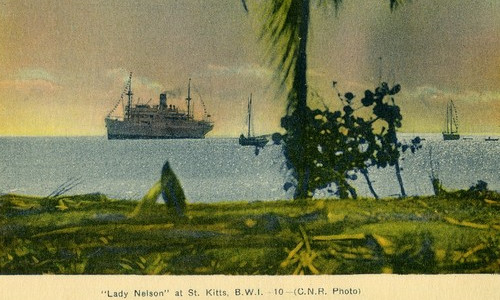
The Lady Boats were liners operated by the Canadian National Steamship Company. They were built by Cammell Laird of Birkenhead, on the Wirral in England and were named after the wives of British Admirals who had served in the Caribbean. They operated between Halifax in Canada, Bermuda and the Caribbean carrying mail, freight and passengers. Lady Rodney and Lady Somers were built for service to western Caribbean while the .Lady Nelson Lady Hawkins and Lady Drake served the eastern Caribbean including St. Kitts and were fitted out to carry more passengers. In 1942 while in Castries, St Lucia, the Lady Nelson was torpedoed by a U Boat. Eighteen persons were killed in the attack. The ship sank at the wharf but was refloated and towed to Mobile, Alabama in the US where it was repaired. For the rest of the war it operated as a hospital ship, carrying wounded Canadian servicemen back home for treatment. The Lady Nelson and the Lady Rodney, the only two of the fleet to survive the war returned to civilian service. The Lady boats facilitated passenger travel in the Leeward and Windward Islands until air travel gained popularity making their continued sailing in the region uneconomic.

A Carnival Journey
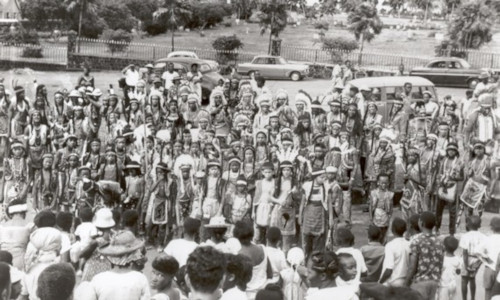
by Stan Lewis
Every year St. Kitts-Nevis celebrates National Carnival but lest we forget, the foundation was laid before 1971. This was due mainly to the efforts of Basil Henderson, a Steel Band Association, a Carnival Committee, social organizations, concerned friends and dedicated individuals.
It was a 1957 proposal that established carnival in St. Kitts-Nevis. However, much of the ingredients were already in place. Steel band was introduced earlier and calypso had been around even longer. Carnival was a new phenomenon, a cultural shift that started in Trinidad and was replicated in Antigua. However, its introduction was not expected to be easy as steel band had faced many challenges before coming into its own and even though calypso survived, there was no formal recognition of that art form.
Up until then, Christmas activities were limited to caroling, worship, family time, private social gathering and street folklore better known as Christmas Sport. The introduction of carnival was expected to provide a national platform, a showcase where different talents could be expressed and recognized officially and publicly. It was also an opportunity to add more flavor, spark creativity and encourage competition.
It was evident, the traditional Christmas celebrations and seasonal festivities were declining. Talented performers had aged, some had passed and many had emigrated to Aruba, Curacao, United States Virgin Islands and England. As far back as April 1946, shipping agent Ryan and Uddenberg advertised It is expected that a schooner will be calling directly for passengers to Aruba and Curacao between the 16 –20th”and in 1948 the Daily Bulletin headlined, More workers leave St. Kitts for Curacao.” Steamships like the T.S.S “Lucania” advertised in local newspapers, enticing first class passengers with cabin and dormitory accommodation for a transatlantic trip to the United Kingdom.
In a 1957 article, the Union Messenger observed that … in recent years the sports-groups have shown marked deterioration, both in appearance and continuity – migration of so many of our people to the UK may be the reason.” Basil Henderson, a community organizer had also assessed that Christmas was “losing its flavor,” the state of street folklore becoming worse each year. So at a meeting at Warner Park on 3rd September, 1957 he solicited help from the Basseterre community to form a Carnival committee in the hope that a Carnival would “encourage strangers and enhance trade.”
Initially, the objective was to stage an annual Carnival Queen Competition. The show was expected to raise funds for a Carnival Queen’s visit to Trinidad with the hope of bringing back to St. Kitts-Nevis, the true spirit of Carnival. Henderson did a great deal of legwork. He garnered support from four firms; each promising to sponsor a contestant while others pledged assistance.
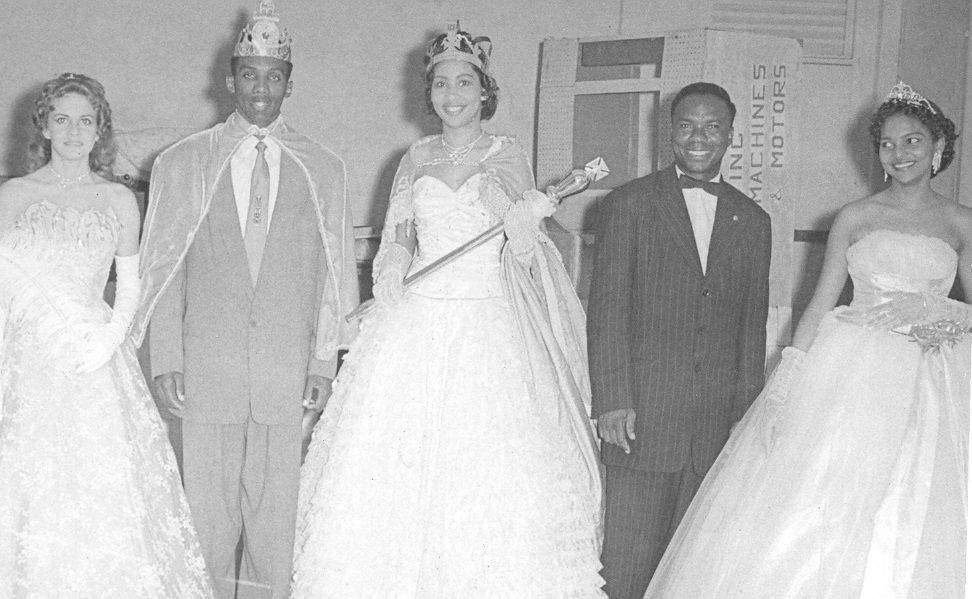
By October the Committee included Major L.N. Alfonso, Tony Lawrence, Leroy Coury, A. Knight, E. Vanterpool, Miss Barker, Mrs. J. W. Herbert, Mrs. Pinnard, Redmill, Mrs. Skerritt, Mrs. V. Vysipal, Miss. M. Malone, Miss Dinzey, Dr. Boyd, Mr. Brisbane, Mr. Belcher, Mrs. Mestier and Mr. P. Evelyn. They were a group of motivated individuals and received support from other prominent individuals, government officials and social organizations like the Jaycees. The group planned several dances to raise funds including one to be held on Halloween and it was decided that the queen show would be held on Saturday December 28 at 8:30 pm at Warner Park. By then, the scope had widened to include a procession of troupes and floats, a calypso show and other activities. Prizes were to be awarded to the best-decorated float, biggest troupe, prettiest troupe, best dancing troupe, best singing troop and prettiest individual. The ambitious program of the 1957 inaugural Carnival listed the following activities:
Wednesday December 18th Official opening of Carnival season
Thursday December 19th Fancy Dress Football Match at Warner Park
Friday December 20th Christmas tree lighting at Pall Mall Square
Saturday December 21st Calypso contest at Warner Park
Monday December 23rd Steel band recital at Pall Mall Square
Saturday December 28th Choosing and crowning of Carnival Queen
Monday December 30th Procession of troupes, floats from Buckley’s to Warner Park
Wednesday January 1st 1958 Carnival Dance from 12:01am to 6.00am
It was an exciting program and preparations soon shifted into high gear. A letter sent to local businesses requested sponsorship of a queen contestant or a troupe and another requested donation of prizes. Following the sponsorship request, fundraising was set into motion. On October 10th, a request was made to Mr. A. Skerritt for the hiring of a downstairs hall for a dance and in addition, an Old Mask Carnival Dance was to be held on December 30th at the Stapleton Cotton House from Midnight Sunday 29th to Monday 5.00 a.m. Admission to the Cotton House dance was 50 cents. Transportation was free, courtesy of the Fallen Angels Carnival Troupe. Patrons were expected to be adorned in elaborate masks and festive costumes and prizes would be awarded for the most original disguises. After the dance, still in costume and a carnival mood, the masked dancers would jam through Basseterre until daybreak, spreading the Carnival feeling.
Word had spread not only locally but beyond the shores. On October 19, J. Marcus Christopher from Antigua, a major figure in that island’s inaugural carnival wrote to Henderson’s committee expressing interest in the festivities. Christopher was already planning a trip to St. Kitts for his Skele-Hoppers, an Antiguan troupe of over 50, to be accompanied by Antigua’s Brute Force Steel Band.
The historic day arrived and on Wednesday, December 18th 1957 at 8pm, St. Kitts first Carnival was launched at Warner Park by the Master of Ceremony, the Carnival Committee’s President, Basil Henderson. The President gave an enthusiastic welcome to thousands present and called upon the Hon. F. T. Williams, Minister of Social Services to address the audience. The minister congratulated the committee, encouraged all to have a good time and implored revellers to be on their best behaviour. Following the minister’s brief remarks, Invaders, Casa Blanca and the Battalion steel bands played their road march tunes to the delight of the audience. Then the carnival season was declared officially open by His Honour, The Administrator who encouraged citizens to adhere to the law, demonstrate good conduct and cautioned against getting on the wrong side of the law and into Major Alfonso’s bad books. Major Alphonso, a carnival committee member was also the resident Leeward Islands Chief of Police.
Carnival was off to a good start. Colourful lights, steel band music and fireworks generated a high energy festive inauguration. It lived up to the hype and everyone looked forward to the upcoming events.
The Fancy Football match scheduled for the next day was advertised. Spectators were promised steel band entertainment after the game and like the opening ceremony, a large crowd was expected at Warner Park. On December 19th team members were encouraged to bring a colourful costume and change at the pavilion. One team captained by Major Alfonso included J. Archibald, V. Audain, A. Skeritt, L. James, F. Boikin, A. Thompson, A. James, A. Pereira, V. Buchanan and D. Dickerson while the opposing team led by L. Coury included F. Dorio, L. Gittens, H. Archibald, V. Pi, B. Smith, O. Glasford, Warner, P. Denhert, O. Martin and R. Nelson. The referee was Mr. J. Wade. Excitement was rife and the match lived up to its billing.
The Christmas tree lighting on December 20 was in contrast, a religious ceremony of prayers and carols. Several ministers of faith participated as four choral groups from various denominations ushered in the Holiday spirit, a ceremony conducted with reverence, very much in line with a traditional Christmas service.
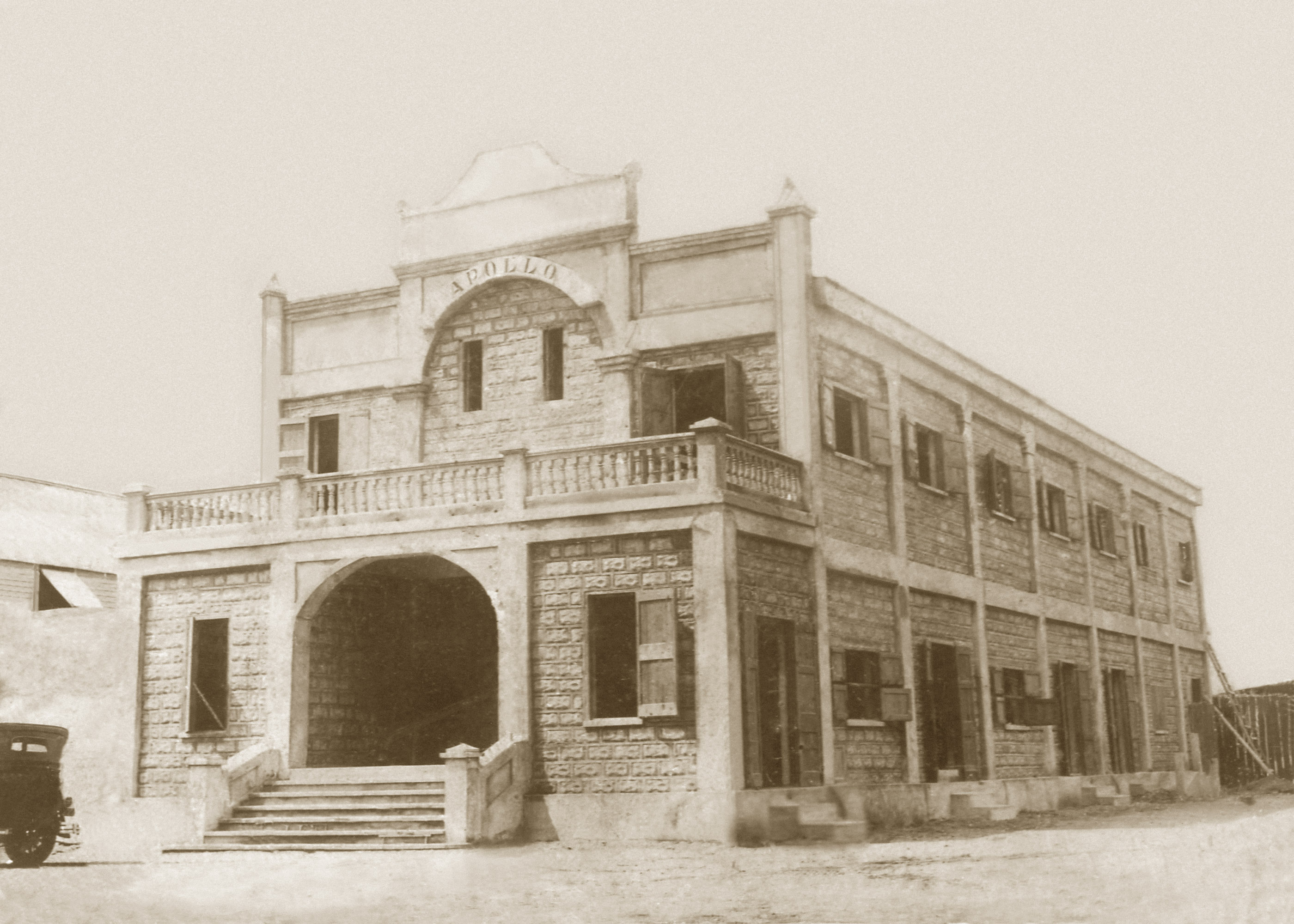
Meanwhile, the venue for the first official calypso competition was changed from Warner Park to the Apollo Cinema. Admission to the event was the usual cinema fee and tickets sold out early. The public very was eager to witness the battle for calypso supremacy and the crowning of the first Calypso King of St. Kitts.
Calypsonians had been practicing for a while and an anxious audience awaited their renditions. Soon the wait over and on December 21, 1957, the event started at 8:30 pm sharp. As expected, inside the Apollo was a capacity crowd with much more fans and curiosity seekers outside, in the streets.
Welcoming the audience, both MCs, Major Alphonso and Agnes Skerritt, promised the occasion would become an annual event. Judges for the competition were Mrs. Media Sebastian, Mrs. Iris Howell and Mr. Pat Denhert seated apart, among the audience. Albert Harris then gathered the calypsonians on the stage for the choosing of the order of appearance. Then, Invaders Steel Band entertained the audience with a crowd favorite, Mambo Calypso, a number that was well received.
The battle for calypso supremacy began with Major Alfonso announcing the appearance of the first calypsonian, Lord Mike who opened with, Topic of Salt Pond. Accompanied by the Amstel Steel Band this first song got the crowd’s attention. Lord Esso, backed by Esso Steel Band followed with a rendition detailing a scandal in New Town. The next presenter, Lord Scisco, also accompanied by Esso, endeared the audience with an experience, Hard Times of Phillips’ Village. After Scisco, Lord Shaw appeared accompanied by Invaders Steel Band, with a tune detailing what happened in the General Elections. Next came Lord Antics’ rendering, a personal account about Antics in Nevis, which was such a flop that the audience booed him off the stage. Then it was Beach Comer’s turn. He followed with a tale about Barman Harry.
Next was King Leader accompanied by the Brown Queen Orchestra, singing Can-Can Craze. It was a crowd pleaser and Leader received a long, vigorous applause. The Mighty Kush sang about The School Teacher and the Boy which was also well received. Mighty Zorro backed by Casa Blanca Steel Band then sang about a recital at the Apollo, the competition venue. Unfortunately, Zorro’s tune did not go over well and again the audience did not conceal its displeasure. The next calypsonian Lord Tracey, accompanied by the Brown Queen Orchestra, delivered a Hammond Report, the confession of an illicit distiller. However, his distilling was unrefined and received similar treatment as Zorro’s.
Lord Harmony was next, also accompanied by the Brown Queen Orchestra. Harmony’s rendering of The Teacher and the School Girl delighted the audience and was such a superb presentation, MC Alphonso described the rendition as favorable to any Trinidadian composition. Needless to say, it was a tough act to follow but the next contender did not disappoint the audience. It was Mighty Saint delivering an exciting performance with a tune, Glory Mamma Glory. Following Saint was Lord Rhymer who held his own, closing the round.
It was exciting and the audience was pleased with the performances, notwithstanding the boos. The Amstel Steel Band entertained the audience during an interlude playing some popular numbers but it was soon time for the second round.
As the last note sounded, Major Alphonso promptly welcomed the audience and asked everyone to be seated. The second round maintained the same order of appearance and once again began with Lord Mike, and his Calypso Carnival, a fitting topic, predicted and promoted a great carnival. Next was Lord Esso a social scientist, espousing a theory, Why Girls love Policemen. Following Esso was Lord Scisco in a celebratory mood singing a timely tune about The Coming Carnival. The next calypsonian Lord Shaw, delivered a prognostication, a Carnival Prediction and then it was King Leader who launched in space singing about Liaka, the Dog in the Satellite. However, Mighty Kush, the next presenter was still on earth concerned about an age-old financial crisis, Child Support. Beach Comber followed and redeemed himself with a tune about beauty, singing about the splendor of Miss Universe. The next presenter Mighty Zorro, already in a carnival mood, energized the audience with a “Carnival Bounce” while Lord Harmony remained calm and philosophical singing Don’t Choose By Favor. The Mighty Saint closed out the contest with a festive tune celebrating The First Carnival.
The hour of judgment was at hand. There was much excitement inside the Apollo was filled with excitement echoed by delayed applause outside. In the theater and on the street one thing was on everyone’s mind: who would be the first crowned calypso king.
Meanwhile the judges came face-to-face in front of the stage. Deliberations were short as all had arrived at the same conclusion. The results were handed to Major Alphonso who wasted no time making the announcement. Lord Harmony (Joseph Williams) was announced the third place winner while Lord Saint (Wicliff Pascall) was awarded second place. There was loud applause then an uneasy quiet. The audience held its breath. Then came relief, the big news. Mighty Kush was declared first Calypso King of St. Kitts.
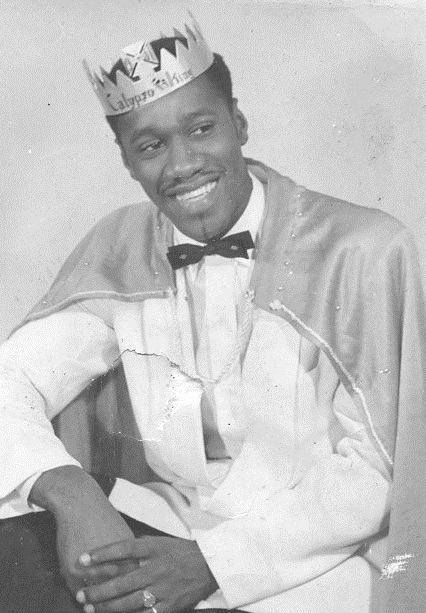
The much awaited decision was met with a loud applause and endless cheer. That night, inside the Apollo was filled with excitement which was echoed in a delayed applause from the much larger crowd outside. To close out the event, queen contestant Christine Coury, ‘Miss AGFA,’ was bestowed the honor of crowning the first Calypso King.
The audience was pleased with the performances and the decision. The standard of the competition was surprisingly high, and so impressive that the St. Kitts-Nevis Daily Bulletin editorialized, … it is interesting to note that most of the compositions are actually on par with some from Trinidad - the Land of Calypso. The same article also suggested that a Calypso Queen competition could produce similar results.
Friendly and Benevolent Societies
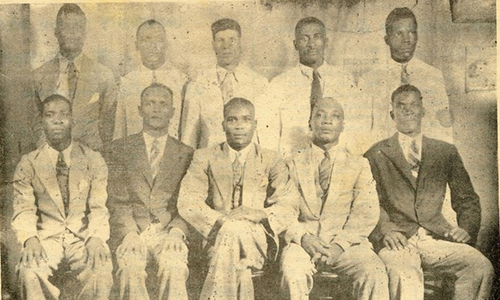
In the post-Emancipation society, labourers were being paid wages for the first time and needed to find ways to ensure they saved for future needs. A number of individuals, often labourers with entrepreneurial skills found ways of starting saving schemes.
By the mid-1840s this was arousing the concerns of the Administration as there was no regulation about how these schemes should be managed and it was suspected that they were designed to deprive labourers of their earnings. In 1847, the local government created its Savings Bank although it did not become functional till some years later. However, the fact that planters and merchants were involved in the management of the Bank could not have endeared the institution to the labourers.
Friendly societies, or benevolent associations were often the answer to this problem. In 1854 Richard Davoren and Samuel Berridge submitted a report to the Board of Council on the Friendly Societies in existence at the time. It showed the fluidity of these organisations and the very amateurish way in which they were run. The Society associated with St. George’s Church had once had a membership of 500. It had been reduced to 155 at the time of the report. They had deposited funds in Colonial Bank which they had used for charitable work and to repair the church. The report rightly viewed this as inappropriate use of funds. The two men had been unable to acquire copies of the rules of the society despite repeated requests. Another Society had been in existence in St. Peter’s but information concerning it had been in the memory of the late rector. It too had placed funds in Colonial bank. Its rules demonstrated a lack of security in dealing with funds, the unfettered power of patrons to expel members and the lack of an appeal process for such expelled members
Friendly Societies were made up of a group of persons who joined together for a common financial or social purpose. Their goals went further than the partner-hand which was often of short duration. Their membership paid a certain amount every week to a treasurer. The sums collected helped finance contributions towards the cost of funerals and to help in times of sickness. Workers worried about how they would cope when such personal calamities struck. By pooling together the resources of a large number of members, they were able to provide some relief in times of stress.
In the 20th century the major groups were
- The Heart and Hand
Was founded in 1909 by John Warner of Cayon who was shocked by the sight of a pauper’s funeral and formed the society to make sure that such events would be kept to a minimum. After a slump in membership, the leadership of the organisation was taken over by Warner’s nephew, Icen Wharton. Along with his collegues he worked hard to motivate people to join and in 1959 when the society celebrated its 50th Anniversary, the Heart and Hand had 1700 members and three halls.
- The Unity Friendly Society also known as the Black and White
Was formed on the 28 Fen 1932 by eleven young men from the villages of Haynes Smith and Russell. Its main driving force was Charles W Huggins, its first President. Walter Cotton was its Secretary and Vernon Wilkes was its Treasurer. The other members of the founding group were Edward Berkeley, Edward Magro, Henry Payne, Ezekiel Osborne, Thomas Lester, Alan Adams, and James Webbe. The organisation was still going still functioning in 1982 when it celebrated its 50th anniversary.
- The Eastern Benevolent Society
Still operates a funeral home.
The Benevolent or Friendly Societies tended to follow the example of the Masonic lodges and adopted some of the paraphernalia often parading at funerals. This helped to show solidarity of membership and attract new members who would then become aware of the benefits that the society provided. But while the Masonic lodges had an exclusively male membership that was mostly white or at least upper class, the benevolent societies attracted black membership and included women. Even the “Union” or as it was officially called, the Universal Benevolent Association catered for sickness and funeral relief, but its focus remained on working conditions. The tradition was carried forward into the Trades and Labour Union when it was founded in 1940.
In 1967 government launched the National Provident Fund. This was the start of the social safety net that was to become Social Security. Contributions to the Fund were made through deductions to wages. It was not a voluntary membership. Ten years later it merged into a bigger Social Security. Soon after its inception, the SS Board started providing a sickness benefit, and a funeral grant. Other benefits were added over time and to assist people during financially stressful times in their lives. This has resulted in the diminished importance of the Benevolent Societies and their eventual disappearance.
vFounders of the Unity Friendly Society
National Archives
Government Headquarters
Church Street
Basseterre
St. Kitts, West Indies
Tel: 869-467-1422 | 869-467-1208
Email: NationalArchives@gov.kn
Website: www.nationalarchives.gov.kn
Follow Us on Instagram

